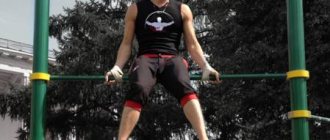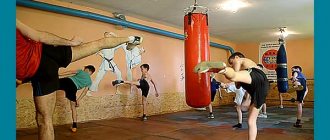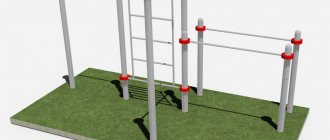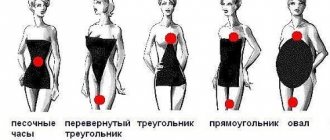What materials can pancakes and barbells be made from? Detailed step-by-step instructions for making it yourself. When visiting sports stores, many athletes simply lose the desire to exercise - just look at the price of barbells and other sports equipment. But don't despair. If you have the time and desire to practice, you can make weight plates and a barbell with your own hands. Of course, a projectile made by yourself will not look as impressive as the finished product. But what we need is not beauty, but efficiency. Is not it? Below we will look at the most budget-friendly and popular option for making a projectile with your own hands.
Advantages
DIY barbells:
fashionable fitness centers with thousands of exercise machines are a waste of money, because in order to develop beautiful muscles, you only need basic equipment:
- Barbell
- Dumbbells
- Multiple racks
But if you look at it, a barbell is enough to pump up the entire muscle corset, look:
♦ Barbell squats – legs
♦ Military shoulder press
♦ Biceps curl
♦ French triceps press
You see, all basic elements are performed using one projectile. Many people go to the gym thinking that only there they can become big, but this is not true.
I advise you to read the article to the end, choose one of 5 ways “how to make a barbell at home” and start a new, sports life tomorrow.
Practical barbell at home, 5 variations
Preface: in the article, I will not name the exact dimensions, since everyone at home has different materials and diameters of structures, therefore, I will give general information and attach pictures, and then you can easily figure it out for yourself.
Method 1 . A rod made from paint cans
As for me, this version of a barbell at home is very easy to make yourself, and in the end something beautiful comes out, especially if you paint it.
Materials:
- Steel pipe 2-3 meters (diameter is chosen based on the principle of comfortable grip)
- 2 pieces of steel pipe 30 cm each
- 2 3 liter paint cans
- Cement
Barbell manufacturing technique:
♦ Take 2 paint cans and cut off the bottom
♦ Next, 2 pieces of pipe 30 cm each (it is important that they are slightly larger in diameter than the main neck)
♦ Then, we fasten 2 blanks in a jar using aluminum wire, in the same way as shown in the picture (our task is to make supports in order to pour concrete in the future, and the tube remains empty in the center)
♦ After the blanks have been laid out, place the jars standing on a flat surface
♦ Pour cement inside, place a brick on top, and wait for it to dry completely
♦ We insert the main bar into the holes, that’s all – the barbell is ready with your own hands!
As a result, we get a barbell that we made at home, spending only a few hundred rubles on cement. The plates can be removed and new ones added in just a few seconds, allowing for rapid progress in muscle mass.
The most important advantage of the design is that the cans will prevent the cement from crumbling.
Forward!
Method 2 . DIY bottle bar
The advantage of this method is its simplicity; it requires a minimum of materials, and you can make a barbell from bottles in an ordinary apartment.
Materials:
- 8 bottles of 2 l
- Main neck
- Sand
- Scotch
The projectile will be difficult to disassemble, so it is better to immediately decide on the weight or make several rods.
Manufacturing process:
♦ We take bottles that are equal not only in volume, but also in the same shape
♦ We go to the sandbox, where we fill the bottles and compact the sand in them well
♦ Next we start winding the pancakes
♦ We tie 2 bottles with tape, then we tape them tightly to the bar, when 2 are already holding well, add 3 and 4
♦ 2nd side the same.
Be responsible when fastening with tape , and it is advisable to weigh 4 bottles before fastening and form equal sides by weight, so that there is no imbalance during classes.
Method 3 . Barbell with bricks
I also had such a bar at one time, its main advantage is the low weight of the bricks, which means you can control the weight and add little by little if necessary.
Materials:
- 10 bricks
- Vulture
- Stone drill
- Grinder and stone circle
Manufacturing process
♦ First step, drill a hole in each brick, slightly larger in diameter than the main neck
♦ Step 2, use a grinder to cut the corners and form circles from the bricks
♦ Adjust the bricks to the same weight, or hang them and sign them
♦ Put on homemade pancakes and play sports (good luck)
It’s very easy to make weight plates for a barbell with bricks; if you use the projectile carefully, the barbell will last a long time. And thanks to the fact that the load can be increased gradually by throwing a few pancakes, progress will not be long in coming.
Method 4 . Barbell made of cement circles
The technology for making such a barbell at home is quite simple, all you need is:
Before making a barbell, I’ll first tell you about cement molds:
♦ We take a metal sheet and cut a strip from it, 10 cm wide, and the length is up to you
♦ Then, we wrap the pole with a strip of tin, and bend the ends in different directions and fasten them
♦ When the shape has taken on a rounded shape, we make a bottom for it with a welded tube in the middle
♦ Pour cement into the mold and wait for it to dry. To better understand the process, look carefully at the picture
Then everything is simple, we make several of these discs and start playing sports.
Method 5 . Rustic wooden rod at home
If you are from a village, like me, and don’t know what you can make a barbell from, then the next method is for you.
Materials:
- Solid wooden circle made from cut wood
- Several kilos of old nails
- Wood drill
- Wood file
- And other metal objects that can be hammered in
Next, a simple manufacturing process
♦ We go to cut down old trees, or to a place where they process forests
♦ We cut out or ask for a solid wooden circle 10 cm thick, you choose the diameter yourself, which circle will be convenient for you to lift
♦ Make a hole in the middle for the neck
♦ Then, we hammer into our wooden circles everything that can be hammered into wood (staples, nails, other garage debris, like an idea - buy slate nails)
Using available materials, we fill the tree with metal to increase the weight, hang weights so that the barbell is balanced - you can begin to conquer the heights of sports.
All these methods are primitive, the equipment does not turn out beautiful, but we don’t need this - muscles grow from weight, and not from the object that we hold in our hands during exercise.
I hope that I have fully covered the question “how to make a barbell with your own hands” and have provided the necessary options to make your dream come true .
Manufacturing stages
Making your own bench press is divided into several stages. First you need to prepare or find a drawing of such a product on online resources. Then you should stock up on all the necessary materials and tools. The final stage involves assembling the finished product.
It is worth noting that when making a bench press yourself, you must use only high-quality materials. Otherwise, the finished product will be fragile and, as a result, unsuitable for use. The adjustment elements that will be equipped with the finished simulator must work without any jamming. At the final stage of bench production, it is recommended to additionally coat it with a hypoallergenic and special water-repellent coating, which will prevent oxidation and rust on the metal surface.
Materials and tools
The process of making a bench press with your own hands is not very complicated. To make such equipment yourself, you need to stock up on a small amount of material and tools.
You will need:
- Welding machine.
- Roulette, ruler.
- Electric drill.
- Grinder (angle grinder).
- Vise.
Also, to make a bench, you should stock up on a profile pipe measuring 40x40 mm with thick walls. To make individual elements of such a structure, you need a steel strip and a thick pipe. The width of such a strip should be about 4 cm.
| № | Name, description of the part | Material | Quantity (pcs.) | Length (mm) |
| 1 | Front struts | Profile pipe | 2 | 830 |
| 2 | Connection for A-pillars | Profile pipe | 1 | 520 |
| 3 | Rear pillar | Profile pipe | 1 | 340 |
| 4 | Bar for connecting the front structure and the rear pillar | Metal | 1 | 970 |
| 5 | Extensions to the A-pillars | Profile pipe | 2 | 220 |
| 6 | Extension to rear pillar | Profile pipe | 1 | 300 |
| 7 | Steel strip (for making petals) | Metal | 1 | 400 |
| 8 | Fabric, foam rubber | Rubberized, dense fabric is used | 1 | Dimensions are calculated depending on the size of the lounger |
| 9 | Metal sheet (for sun lounger) | Metal | 1 | 990 |
Required Tools
Drawing up a drawing
At the initial stage, before making a bench press, you should draw up drawings of the future product. You can do it yourself by first taking all the necessary dimensions of the components and elements from the finished product, for example, by visiting the gym. Also, a ready-made sketch (the generally accepted standard of such a bench), with dimensions and proportions already indicated, can be found on various online resources.
When drawing up a drawing, you need to take into account all the design features of the future sports simulator and accurately indicate the dimensions of the bench and its individual elements (width, height, length of racks, as well as special extensions).
Regular bench
Incline bench
Compact weight bench
Sports bench frame
Assembly
First, you need to make special racks for the barbell with your own hands, which in the design will play the role of legs of the entire frame, and also support the barbell during strength exercises. It is worth noting that such racks must be made of high-quality and durable material, since they will bear a large load. As a rule, for their manufacture a profile pipe is used, which is divided into two sections 830 mm long.
Assembly sequence:
- On the racks, using an ordinary pencil, you need to make a special mark, in the area of which they will be connected to each other. The point should be above the floor level (approximately 34 cm).
- Then you need to take a piece of profile pipe, the length of which is 520 mm, and weld it to both posts at the point of their connection. During welding work, it is necessary to take into account the fact that it is at the points of contact of the racks that heavy loads and pressure will be exerted. The distance from the weld seam directly to the floor surface must be strictly 340 mm.
- Make a rear pillar and weld it to the main structure. To do this, you can use a section of profile pipe 340 mm long. To connect it to the main structure, a metal strip 970 mm long is used.
- In order to evenly distribute the load on the surface of the floor covering of the structure, special extensions must be welded to the legs. They can be made from a profile pipe. For the front legs, a length of 220 mm is required. To make the rear pillar more stable, it is also recommended to weld an extension from a profile pipe, the length of which is about 300 mm, to it. As an alternative, metal corners can be used.
- Then, from steel strips, using a vice, you need to make several petals for the racks (2-4 pieces), the shape of which should be similar to the Latin letter “J”. The size of the rear side of such a petal is 7 cm, and the front side is 3 cm. The finished elements are welded evenly to the front posts of the structure and serve to hold the rod.
At the final stage you need to make a sunbed (bench). To make it you will need steel sheets, the thickness of which is about 2 mm, foam rubber, board, reinforcing rods, fabric. It is worth noting that the lounger can also be made of wood, which, after being installed on the bench, is covered with foam rubber and fabric. In terms of its strength, a homemade wooden bench is practically in no way inferior to its counterparts made of metal.
To make a sunbed, you need to take a sheet of metal, drill several holes in it, and using ordinary self-tapping screws, attach a sanded board to its surface. Then reinforcing rods are welded to the metal sheet. At the next stage, a sheet of metal with a board is attached to the main structure of the bench. Then foam rubber is attached to the board using glue, which will later need to be covered with fabric. In this case, it is recommended to use high-density rubberized fabric. In this way, you will be able to create a fairly durable bench that will last for many years.
Welding the frame for the insert seat
Strength test
Installation of the foot attachment
Cutting insulation for plumbing pipes
Holes are drilled in the main seat and furniture bushings are driven in for 8 mm bolts
Dense foam rubber 50 mm thick is glued onto the seat, then the seat is upholstered with leatherette
Ready press bench
Types of dumbbells
For many who want to play sports, the question of visiting the gym is closed due to lack of time, and their own sports equipment for exercising at home is not so cheap. Despite the ease of manufacture, the sporting goods industry is simply not interested in selling pieces of metal for cheap.
Before you make them yourself at home, let’s figure out what they are and what their varieties are. All dumbbells are divided into cast and collapsible. The first ones have a constant mass; it can only be changed by destroying the dumbbell. Most often they are used in gyms, since there should always be access to equipment of the required weight and no one wants to waste time assembling and disassembling it.
The second ones consist of a bar and plates or other types of weights. They can often be found in home gyms, since this option is cheaper - buying two dumbbells weighing 20 kg with the possibility of reducing the weight is much cheaper than purchasing 2, 4, 6...20 kg separately.
Dumbbells are also made from different materials - concrete, cast iron, steel coated with rubber, etc. The material and coating create ease of use and affect the durability of the product.
There are also differences in the form of the pancakes that are hung on the bar. It can be round, hexagonal and other designs. Available with self-regulating weight. Every day new options appear that can be called high-tech, but the price of such equipment is not commensurate with their benefits - there is no point in overpaying.
How else to make a barbell yourself at home
For a home sports corner, you can make almost all the equipment if you have some skills and knowledge. For example, making a barbell at home is not that difficult.
The main part of the barbell is the bar. It needs to be strong enough to withstand the hefty weights you'll have to lift. A reliable bar will allow you to properly distribute the load and allow you to exercise without fear for your health.
The optimal choice as a material for the neck of a homemade barbell would be steel reinforcement. You should not choose a rod that is too thin if you are going to lift heavy weights. But even if you take thick reinforcement as a basis, keep in mind that its weight will not be small.
If you can’t find steel reinforcement, you can use an iron pipe, a strong crowbar, or, as a last resort, a wooden handle. But be sure to check them for strength.
If you are using a hollow iron pipe, fill the cavity with concrete or thinner reinforcement to make it stronger and heavier.
A barbell for your home can be made from other available materials.
To lift small weights, you can use a bar made from a shovel handle, attaching small loads to it in the form of cans, tires, or other things.
For more advanced training, you can use a barbell with a reinforced bar. It is advisable to make a thread at its ends and secure washers so that the pancakes do not slip off.
A simple rod for the home can be made from an iron pipe with a diameter of about 4 centimeters. If the pipe is hollow, it must be filled with any filler (concrete, metal, sand). It is necessary to make threads at the ends of the pipe so that pancakes or other weights do not move out and cause harm.
For such a barbell, you can use threaded lead disks or other weights that can be securely fastened to the bar.
If the barbell is needed not for record achievements, but for light training, then instead of powerful loads it can be supplemented with weights made from plastic bottles. This is the simplest and cheapest option for home use.
You will need 8 bottles of the same volume and filler for them. It could be sand, cement, water, crushed stone or something else.
Use tape to secure 4 bottles together. Do this as securely as possible.
Insert the bar into the space between the four bottles. Secure a homemade weight plate to the bar so that it does not move during exercises.
Do the same with the second pancake.
In the same way, you can make dumbbells for home use.
Material options for a homemade barbell
There are two simplest options for fretboard materials: iron or wood. It’s easy to decide on a wooden base for the bar, since you can use, for example, an old wooden rake. The advantage of this option is that the tree will not add extra weight to the bar if it is not necessary.
To turn a rake into a suitable form for a projectile, you need to remove its handle in any suitable way, the main thing is that only one stick remains from it, which will be used as a basis for pancakes. We’ll look at what else you can use to make a barbell and weight plates below.
Another option for the bar could be, for example, a metal rod if you are planning classes with a weight of more than 50 kilograms.
The length of the rod should be 2 meters, and the cross-sectional diameter should be 35 millimeters; these are the optimal requirements for comfortable playing sports. You can also use a metal pipe with a diameter of 4 centimeters, but it is not suitable for the heavy weight of the pancakes.
We create inventory from plastic
Do not skimp on adhesive tape and tape - poor fixation of the dumbbell elements can lead to its destruction
You can assemble dumbbells quickly and very cheaply by using plastic bottles. Due to the simplicity of the design, you can practice with such projectiles immediately after production. For one dumbbell we need: 2 plastic bottles; filler; insulating tape/adhesive tape.
Manufacturing
- The middle part of the bottles needs to be cut out, and then the top and bottom parts must be reattached with adhesive tape.
- Then you need to fill the resulting containers with filler. Sand and cement are excellent fillers, but if you need more weight, then feel free to add nails, scrap metal, balls from bearings, in general, let your imagination run wild.
- After filling, you need to insert a wooden or metal shelf or pipe into both necks. Cover the areas with tape or duct tape. You will get a very comfortable, soft and non-slip handle.
Assembling the barbell
You can also assemble a barbell from plastic. Since it itself implies a lot of weight, you need a lot more bottles. For the bar you will need: plastic bottles, at least 8 pieces; filler; fingerboard; tape/duct tape.
- As a neck we use a pipe and fittings that are comfortable for the hand.
- We fill the bottles in the same way as in dumbbells.
- Place the finished weight around both ends of the bar and wrap it with tape. We get four bottles on each side, between which the bar passes. Tape the weight securely to the bar so that it does not move or cause play.
- For a more impressive weight, we take another load and place it in the spaces between the existing bottles, like logs. We recommend wrapping each new layer with new tape - this way you can increase the weight of the bar up to 100 kg.
| 2 liter bottle filler | Weight, kg |
| Water | 1,997 |
| Sand (compacted) | 3,360 |
| Sand (wet) | 3,840 |
| Lead | 22,800 |
| Crushed stone (pestone) | 2,600 |
Step-by-step production
To make a bench press with your own hands, you need to prepare the necessary materials, select and correct the drawing. The procedure for creating a bench consists of two stages: the production of a frame and a deck chair. To manufacture the product, experience with construction tools is required. You can make your own exercise machine from wood and profile pipes.
Made of wood
To manufacture the structure, you will need furniture panels and wooden beams. The bench elements are fastened with bolts and nuts, nylon and body washers, self-tapping screws, and wood glue. Using rubber pads on the legs you can protect the floor covering from scratches. From the materials you need to prepare a circular saw, a jigsaw, a chisel, a grinder, a drill, and wrenches. The bench is made using a drawing with dimensions and step-by-step instructions:
- Wooden beams are cut in accordance with the diagram.
- The grooves necessary for mounting the supports are cut out on the central bar. The parts are connected using fasteners and glue.
- Cross bars are mounted on the supports. The bolts should be recessed into the elements; holes must first be made in them.
- Small bars, pins and bolts are used to make elements that regulate the height of the deck chair.
- The shield is fixed to movable bars; depressions are cut out in the central one to install a rod that will help change the height.
A finished wooden structure will last longer if the elements are impregnated with stain and then covered with a layer of varnish. A convenient exercise machine will help you build muscle mass, pump up your triceps and deltoids.
Criteria for choosing a bench for a bath, recommendations for processing and care
Prepare a drawing
Saw the wooden beams in accordance with the diagram, cut the grooves necessary for mounting the supports on the central beam
Place the crossbar on the supports and secure it
Attach bars of smaller diameter to the side of the main crossbar
Using studs and bolts, make elements that regulate the height of the deck chair.
Attach a plywood panel to the movable bars
Cut depressions in the central beam to install a rod that will help change the height
Impregnate the finished structure with stain and cover with a layer of varnish
From profile pipes
Making a home simulator begins with preparing pipes with a cross-section of 4 x 4 cm, steel sheets, sanded boards, fasteners, and the necessary tools. The work includes several stages:
- The creation of the frame begins with cutting profile pipes. You will need 2 pieces of 83 cm each. These elements can be used as racks and support for the barbell.
- Cut a piece of pipe 52 cm, this is what will connect the legs. The fourth piece, 34 cm long, will be needed to mount the rear part of the rack.
- The front and rear knives are fastened with a 97 cm piece of pipe. It is welded to the rear pillar; self-tapping screws can be used for this.
- Pre-prepared petals consisting of steel plates are fixed to the supporting parts. The long side of these elements should be 7 cm, the short side - no more than 3 cm.
- Holes with a diameter of 1 cm are made in the crossbar that connects the front pillars. 30-centimeter rods are placed in them, with the help of which the height of the lounger will be adjusted.
- The bench consists of two parts. The short sheet is fixed at the back of the structure, the long sheet at the front. Fastening is done using a furniture hinge, which is welded to the frame.
- Reinforced rods necessary for raising the sunbed are fixed in the lower part.
- A wooden board is fixed to the steel sheets, the width of which should be 5 mm larger than the metal elements.
The final stage of manufacturing a metal simulator will be preparing the hole for installing the board and welding the fasteners to the support. This is done in 3 places to increase the stability of the structure. Next, the lounger is fixed with self-tapping screws, and the product is completely ready for use.
The bench press bench is considered one of the most popular sports equipment. The high-quality design allows you to fully pump the chest muscles, which contributes to the formation of a beautiful torso. For home activities, it is not at all necessary to purchase expensive equipment; you can make a bench yourself using wood or profile pipes.
Cut the pipes according to the diagram
Mark the joints of the parts
Cut support
Weld the support to the rear pillar from above, and to the front pillar from the side
Prepare petals from steel plates and install them on racks
Cut corners and drill holes to attach the board
Weld the fasteners to the support element in three places
Secure the bed with self-tapping screws
Fix the seat on a metal blank. Install the backrest and lounger.
Install the adjustment foot
The simulator is ready
Nuances when making a homemade barbell
When making a homemade barbell, you need to consider some points:
The bar must be strong to support the weight of the plates;
The bar should not be too thick or thin, it should fit comfortably in the hand;
If the neck is made of metal, it is worth supplementing it with anti-slip rubber inserts;
The weight of the pancakes should be the same;
When making pancakes from cement, be sure to wait until it hardens completely;
Be careful when performing exercises with a homemade barbell.
Don't be afraid to seek help from professionals.
The sports lifestyle is becoming increasingly popular. But not everyone has the opportunity to constantly visit fitness clubs. Therefore, many decide to make their own sports corner at home.
Buy or make it yourself
To perform a bench press at home, you simply cannot do without a bench. There are two options - buy it yourself or make it yourself.
Purchase in store
Buying the necessary equipment at any sports store is not difficult.
Advantages of buying a bench in a store:
- availability. Having purchased a bench, you only need to install it at home in a suitable place;
- time. It will take no more than 2-3 hours to purchase and install the bench.
Despite the obvious advantages, there are several disadvantages that should be noted.
Minuses:
- high cost of equipment. Very often there is an overpayment for the manufacturer's brand;
- inability to select individual parameters for yourself. Basically, bench press benches are produced in a standard configuration - if the athlete is tall, then it will be difficult for him to choose the necessary bench for himself.
When it is not possible to buy the necessary projectile in a store, you can make it yourself.
DIY making
Almost everyone, even a novice master, can make a bench press at home.
Pros:
- you can choose any parameters of the bench based on your physiological characteristics;
- money. Making a bench yourself is less expensive than buying it in a store.
This choice is suitable for those who do not have large finances or do not want to spend a lot of money in the store.
Flaws:
- time. It will not be possible to make a bench in 1-2 hours; you will have to spend about a couple of days on it;
- tools. If you don’t have the necessary tools in your home arsenal, then it’s impossible to make a bench yourself.
In fact, the store-bought and home-made versions are not much different from each other. If you make the simulator yourself, it will be in no way inferior to the store-bought version.
Criterias of choice
Home workouts should be safe first and foremost. You need to be very careful when choosing a bench press in a store.
Particular attention should be paid to the following parameters:
- Quality. The structure must be made of durable material. It is important to pay attention to the reliability of fastening parts and elements. It is not recommended to purchase exercise equipment with narrow racks, otherwise the load may be distributed incorrectly.
- Compact sizes. Fixed benches are reliable and have good stability. But not every person has the opportunity to allocate a permanent place for this simulator. Folding models allow you to correct the situation. When purchasing this type, you should pay attention to the quality of the folding and transformation mechanisms.
- Functionality. Horizontal benches, as a rule, have limited opportunities for exercise. To increase the versatility of the sports equipment, you can supplement it with the following elements: footrest, parallel bars, handrails, stand with safety stops.
The Press and Abdominal Power Bench is a great machine for working with dumbbells and barbells. For comfortable and productive training, it is recommended to choose the length of the bench so that your head does not hang down during exercise.
Homemade weight plates at home
You can also make weight plates yourself if you are creative. A variety of objects can be used as weights for a barbell. The main thing is that their weight is the same and that they are convenient to use.
What to make weight plates from
Barbell plates can be made from concrete, steel, metal bars, bottles, tires and other materials.
The most popular pancakes are made from concrete and bottles.
Weight plates made of concrete
If you need a barbell with large weights for home use, then the weights can be made from concrete.
In order to make concrete pancakes, it is necessary to calculate the size and diameter of the mounting hole, and then it should be possible to adjust the weights on the bar by removing or adding pancakes.
Materials and tools needed for work
To make concrete pancakes you will need: plywood or wood for edging, plastic mold, cement, sand, wire, armored belt or wire mesh.
Step-by-step production
- We create a form for pouring concrete and secure it to a plywood sheet. Insert a tube with a diameter the size of the bar being used into the center of the mold.
- For reliability, we insert a wire or armored belt into the mold. The wire should be shaped into a circle. It shouldn't be too thin.
- If you use an armored belt, tie its parts together with wire to give the structure strength.
- We make a mixture of sand, water and cement. We take approximately 1 part cement to 3 parts sand. Mix dry ingredients, add water. Pour in some of the mixture. We compact it.
- We lay another layer of wire and fill it with the remaining solution.
- We compact it and wait until the cement hardens - in about a month it will become strong enough.
DIY weight plates
Hello, dear readers, athletes and DIYers! Many of you are involved in weightlifting, but sometimes there is not enough sports equipment. In this article, the author of the YouTube channel “Sergey Mazurin” will tell you how he made 25 kg weight plates for a barbell.
Materials. — Reinforcement — Cement M500 — Washed river sand — Thick rubber — Bolts, nuts M6 — Steel plate 2 mm thick — Sandpaper — Steel tube — Primer for concrete — Wood screws — Plywood sheet, decorative plastic. Tools used by the author. — Screwdriver — Grinder — Welding machine — Wrench, pliers, screwdriver, tape measure, caliper, knife — Rule, trowel. Manufacturing process. So, the main materials from which the pancake is made are concrete, reinforcement, and rubber. Their weight is 25 kg. To obtain a relatively accurate weight the first time, the author performed a few calculations and shares them with you.
Next, the master selected suitable fittings, drew a template, and cut blanks of suitable length. Then I tied them into a reinforcement card.
Using the reinforcement map as a guide, the craftsman cuts blanks for five more such gratings.
After that I simply welded all 6 grates. The author used this amount of reinforcement for the reason that the pancakes were more compact, and not for particularly strong reinforcement. The density of steel is almost 3 times greater than that of concrete.
The next step is for Sergei to start making the formwork.
For this purpose, rubber will be used, which will remain on the pancakes themselves. He placed a sheet of plywood as a base, and decorative plastic on it. It is very thin and smooth. As a result, it will be quite easy to separate the finished product, and the reverse side will be smooth. To fix the rubber, he screwed wood screws into the substrate, strictly observing the circle. To install the steel pipe bushing, I also screwed in self-tapping screws in the center of the circle.
So, all the parts are prepared, in addition, the jumpers are cut.
He wound four knots of wire around the corners of the lowest grille. It will prevent the first layer of reinforcement from falling to the bottom and damaging the surface.
Sergei welded two pieces of reinforcement to the bushings themselves; they will firmly fix the bushing in the body of the pancake.
He will make the concrete mixture from washed coarse river sand, it even contains small pebbles. And cement uses grade M500.
The next stage of preparation before pouring. He screwed two rows of bolts around the perimeter of the rubber formwork at intervals of about 10 cm. He shortened the bolts that were too long with a grinder so that they would not interfere with the installation of the gratings. And the joint was reinforced with a steel plate.
Now everything is ready for pouring. Fill the mold about a quarter full, tamp it down with a wooden block, and lay the lattice with the wire knots down.
Fills the second layer, carefully compacts it again - air bubbles in the structure are completely unnecessary. After pouring, insert the jumpers, resting them on the lower grid. They, of course, could have been welded to the lower grille, but the author decided to do so.
Now you can install the second grate and fill in the penultimate layer.
Fills and compacts the last layer.
For finishing processing, it passes over the entire surface as a rule.
The author left the discs to harden for a whole week. And when I returned to the dacha, I regretted that I had not protected the surface of the rubber with masking tape. Now you have to unscrew all the screws from the backing, remove the pancakes, and clean the rubber from the concrete.
Removing traces of concrete turned out to be quite simple. The rubber bends well, and when you hit it with a hammer, the concrete simply crumbles and flies off. Then I sanded the rubber with sandpaper and coated the surface of the concrete with a primer. On the left in the photo is the upper surface, and on the right is the lower one; it turned out to be so smooth and separated from the mold so easily that the author was even surprised.
Due to the fact that the author did not really trust his floor scales, he installed two weights of 10 and 15 kg on them, and calibrated the scales. Then I weighed the finished discs. The deviation from the calculated weight was about 100 grams.
Thanks to Sergei for an interesting idea for making sports equipment!
Good mood, good luck, and interesting ideas to everyone!
Source
Become the author of the site, publish your own articles, descriptions of homemade products and pay for the text. Read more here.
How else to make a barbell yourself at home
A barbell for your home can be made from other available materials.
To lift small weights, you can use a bar made from a shovel handle, attaching small loads to it in the form of cans, tires, or other things.
For more advanced training, you can use a barbell with a reinforced bar. It is advisable to make a thread at its ends and secure washers so that the pancakes do not slip off.
Making a rod from a pipe
A simple rod for the home can be made from an iron pipe with a diameter of about 4 centimeters. If the pipe is hollow, it must be filled with any filler (concrete, metal, sand). It is necessary to make threads at the ends of the pipe so that pancakes or other weights do not move out and cause harm.
For such a barbell, you can use threaded lead disks or other weights that can be securely fastened to the bar.
Pancakes from plastic bottles
If the barbell is needed not for record achievements, but for light training, then instead of powerful loads it can be supplemented with weights made from plastic bottles. This is the simplest and cheapest option for home use.
You will need 8 bottles of the same volume and filler for them. It could be sand, cement, water, crushed stone or something else.
Use tape to secure 4 bottles together. Do this as securely as possible.
Insert the bar into the space between the four bottles. Secure a homemade weight plate to the bar so that it does not move during exercises.
Do the same with the second pancake.
In the same way, you can make dumbbells for home use.
Model selection
Bench presses are special machines on which almost 65% of the exercises included in the workout are performed. Using this device, you can do barbell flyes, lunges, and cardio exercises. The model is useful for the development of forearms, legs and so on.
The traditional design consists of four supports and a regular horizontal board. The main advantages of the model: simplicity, functionality, practicality. Among the disadvantages, the low stability of the product is noted. Modifications to the standard bench include:
- connected to the racks for the barbell;
- on three supports, where 2 are racks for the bar;
- with adjustable backrest;
- with retractable racks and bars;
- models with a foot block.
With racks for a barbell On three supports
With adjustable backrest
With retractable stands
With a leg block
In addition to standard training benches, there are other models with different functionality. Each option has its own characteristics:
- Inclined. The design can be adjusted depending on the level of inclination of the bench. Pros: the ability to exercise with a barbell in a sitting or lying position, or use other sports equipment. The downside is the limited range of exercises performed.
- Horizontal. It is a rack with a bench and crossbars for a barbell. Pros: height adjustment, working out the pectoral and frontal muscles. Minus - suitable only for professionals.
- Transformer (adjustable bench). These are multifunctional products, complemented by removable blocks for performing a variety of exercises: dips, abdominal swings and others. Pros: versatility, multifunctionality, ability to work different muscle groups. Cons: large dimensions, weight.
A horizontal bench is considered the easiest to make yourself. If you wish and have experience in construction work, you can supplement the design with an adjustable lounger or other devices that are typical for inclined models and transformers.
How to make a universal bench for your garden with your own hands
Inclined
Horizontal
Transformer
Nuances when making a homemade barbell
When making a homemade barbell, you need to consider some points:
The bar must be strong to support the weight of the plates;
The bar should not be too thick or thin, it should fit comfortably in the hand;
If the neck is made of metal, it is worth supplementing it with anti-slip rubber inserts;
The weight of the pancakes should be the same;
When making pancakes from cement, be sure to wait until it hardens completely;
Be careful when performing exercises with a homemade barbell.
Don't be afraid to seek help from professionals.
Video: DIY barbell
If you don't know how to make a barbell yourself, this video will help you.
In order to achieve success in sports, you do not need to buy expensive equipment. Sometimes desire and ingenuity are enough. Therefore, arm yourself with the necessary tools and try to make a barbell with your own hands.
Do you already have experience making a barbell at home? Or unusual ideas about what you can use to make a barbell or plates for a home barbell? Share your thoughts in the comments.
Barbell for sports
A sports barbell is one of the most important items that is useful for a variety of exercises. The barbell is also the main object that makes it possible to exercise with heavy weight, and this, in turn, will give results from sports activities. And this result will be much better than from other sports equipment, although other sports items are also very important.
If a person wants to exercise at home, but does not have the equipment for this, then you can make a barbell at home with your own hands and start exercising with barbell exercises.










